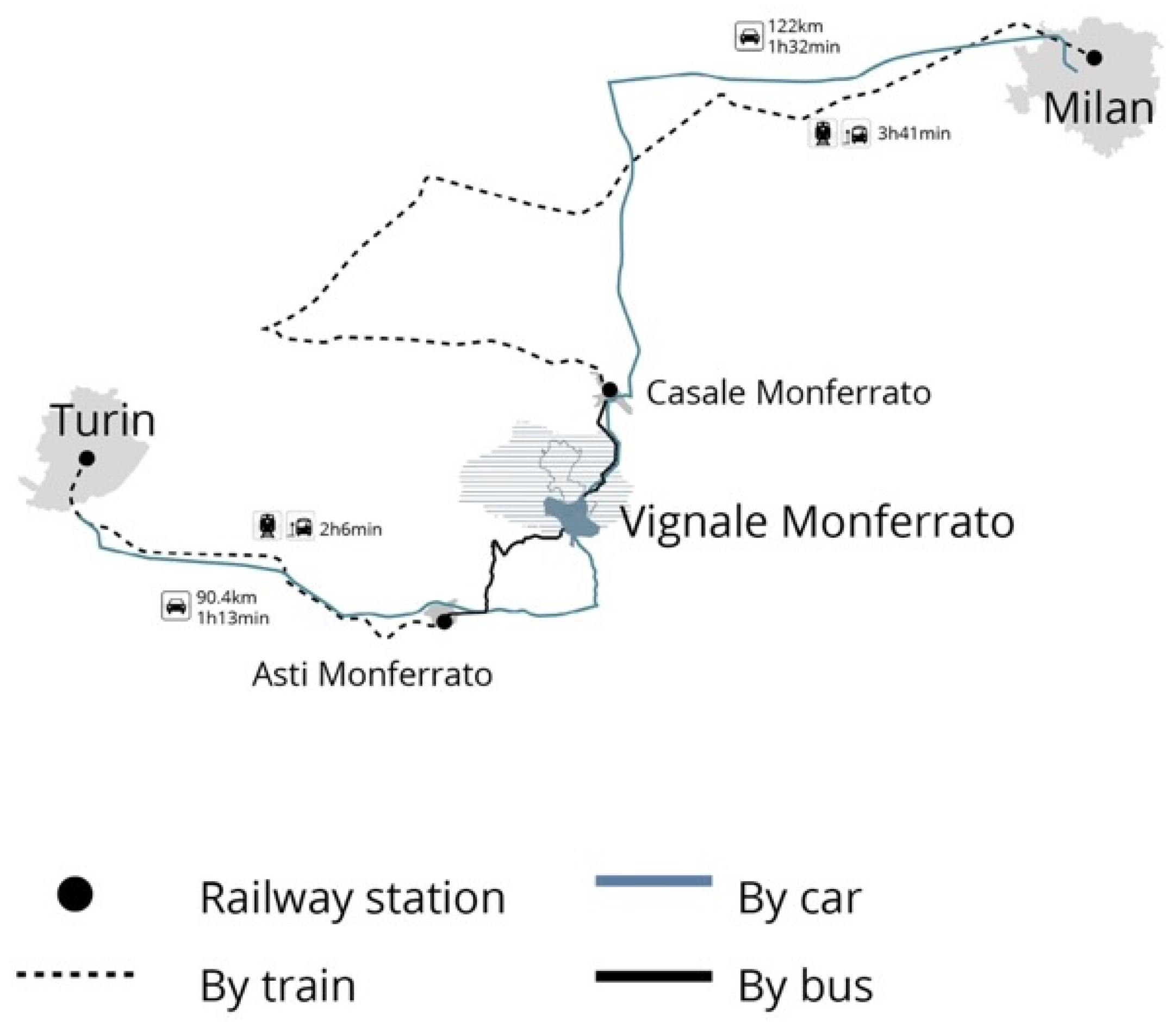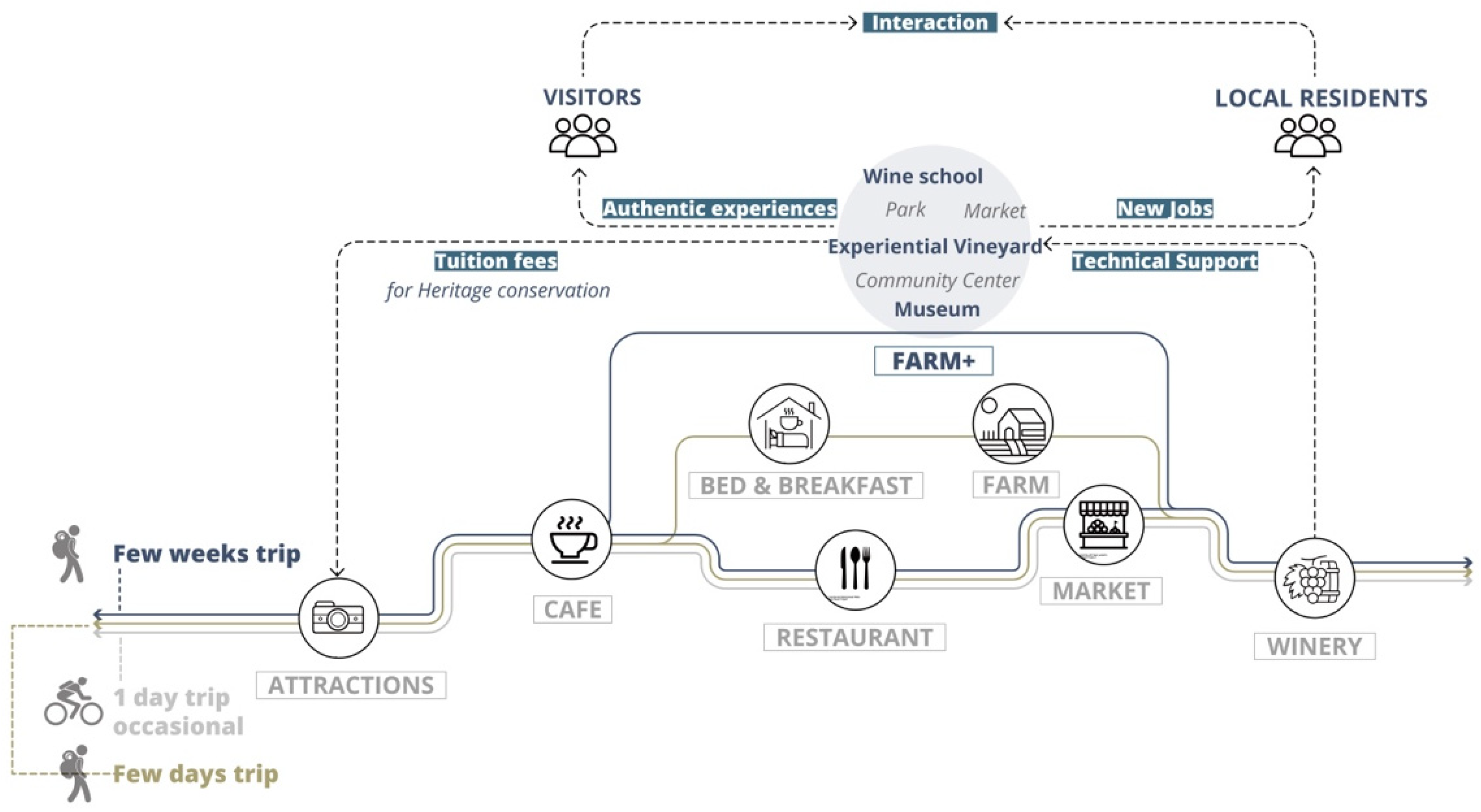The Role of Landscape Design in Cultural Rural Areas. A Didactic Exercise to Experiment a Research-by-Design Process Applied to an Italian UNESCO Wine Site
Abstract
:1. Introduction
2. Materials and Methods
2.1. Approach and Method Adopted
2.2. Analytical Case Studies
2.3. Application Case Study
2.3.1. Regional Analysis
2.3.2. Local Analysis
2.4. The Model
3. Results
3.1. Description of the Project Site
3.2. The Design Process
4. Discussion
5. Conclusions
Author Contributions
Funding
Institutional Review Board Statement
Informed Consent Statement
Data Availability Statement
Acknowledgments
Conflicts of Interest
References
- World Heritage Convention. 1992. Available online: https://whc.unesco.org/en/convention/ (accessed on 26 July 2021).
- Salter, C. The Cultural Landscape; Duxbury Press: Pacific Grove, CA, USA, 1971. [Google Scholar]
- Piccardi, S. Il Paesaggio Culturale; Patron Editore: Bologna, Italy, 1986. [Google Scholar]
- Piccardi, S. Il Paesaggio Culturale in Geografia; Patron Editore: Bologna, Italy, 1987. [Google Scholar]
- Andreotti, G. Paesaggi Culturali. Teoria e Casi Studio; Unicopli: Milano, Italy, 1996. [Google Scholar]
- Andreotti, G. Alle Origini del Paesaggio Culturale. Aspetti di Filologia e Genealogia del Paesaggio; Unicopli: Milano, Italy, 1998. [Google Scholar]
- Barbera, G.; Biasi, R.; Marino, D. I Paesaggi Agrari Tradizionali. Un Percorso per la Conoscenza; FrancoAngeli: Milano, Italy, 2014. [Google Scholar]
- Dezio, C. Paesaggi agrari resilienti. Approcci e Metodi per L’analisi di Pratiche Processi e Strategie Territoriali; FrancoAngeli: Milano, Italy, 2020. [Google Scholar]
- Gulinck, H.; Wagendorp, T. References for fragmentation analysis of the rural matrix in Cultural Landscapes. Landsc. Urban Plan. 2002, 58, 137–146. [Google Scholar] [CrossRef]
- Palang, H.; Alumae, H.; Antrop, M.; Helmfrid, S. Rural Landscapes: Past processes and future strategies. Landsc. Urban Plan. 2005, 70, 3–8. [Google Scholar] [CrossRef]
- Rescia, A.; Willaarts, B.; Schmitz, M.; Aguilera, P. Changes in land uses and management in two nature reserves in Spain: Evaluating the social-ecological resilience of cultural landscapes. Landsc. Urban Plan. 2010, 98, 26–35. [Google Scholar] [CrossRef]
- Solymosi, K. Indicators for the identification of cultural landscape hotspots in Europe. Landsc. Res. 2011, 36, 3–18. [Google Scholar] [CrossRef]
- Dezio, C.; Cavallo, A.; Marino, D. Resilient agrarian landscapes in face of changes: The coevolutive approach to understand the links between communities and environmental characters. In Biocultural Diversity in Europe; Agnoletti, M., Emanueli, F., Eds.; Springer: Berlin/Heidelberg, Germany, 2016. [Google Scholar]
- Dezio, C.; Marino, D. A reading model for Resilience in Terraced Wine Landscape. In Terraced Landscapes: Choosing the Future; Alberti, F., Dal Pozzo, A., Murtas, D., Salas, M.A., Tillmann, T., Eds.; Regione del Veneto, Direzione Pianificazione Territoriale, Strategica e Cartografia: Venezia, Italy, 2018. [Google Scholar]
- Plieninger, T.; Bieling, C. Resilience and the Cultural Landscape—Understanding and Managing Change in Human-Shaped Enviornments; Cambridge University Press: Cambridge, UK, 2012. [Google Scholar]
- Rey Benayas, J.M.; Martins, A.; Nicolau, J.M.; Schulz, J.J. Abandonment of agricultural land: An overview of drivers and consequences. CAB Rev. Perspect. Agric. Vet. Sci. Nutr. Nat. Resour. 2007, 2, 14. [Google Scholar] [CrossRef] [Green Version]
- De Rossi, A. Riabitare l’Italia. Le Aree Interne Tra Abbandoni e Riconquiste; Donzelli Editore: Roma, Italy, 2018. [Google Scholar]
- SNAI. Strategia Nazionale per le Aree Interne. Available online: https://www.agenziacoesione.gov.it/strategia-nazionale-aree-interne/ (accessed on 15 October 2021).
- OECD. Multifunctionality: Towards an Analytical Framework; OECD Publishing: Paris, France, 2001. [Google Scholar] [CrossRef]
- Zhang, C.; Zhang, Y. Design with Landscape. An Experimental Model towards a Goal of Resilience in Vignale Monferrato. Master’s Thesis, Politecnico di Milano, Milan, Italy, 23 July 2021. [Google Scholar]
- Roggema, R. Research-by-design: Proposition for a methodological approach. Urban Sci. 2017, 1, 2. [Google Scholar] [CrossRef]
- Frankel, L.; Racine, M. The complex field of research: For design, through design, and about design. In Proceedings of the Design and Complexity—DRS International Conference, Montreal, QC, Canada, 7–9 July 2010; Available online: https://dl.designresearchsociety.org/drs-conference-papers/drs2010/researchpapers/43 (accessed on 15 October 2021).
- Common Agricultural Policy. Available online: https://ec.europa.eu/info/food-farming-fisheries/key-policies/common-agricultural-policy_en (accessed on 26 July 2021).
- Regional Landscape Plan of Piedmont. Available online: https://www.regione.piemonte.it/web/temi/ambiente-territorio/paesaggio/piano-paesaggistico-regionale-ppr (accessed on 15 October 2021).
- Langhe-Roero Monferrato UNESCO. Available online: https://whc.unesco.org/en/list/1390/ (accessed on 26 July 2021).
- UNESCO World Heritage. List The Vineyard Landscape of Piedmont: Langhe-Roero and Monferrato; Nomination Book; UNESCO: Paris, Italy, 2014. [Google Scholar]
- ISTAT Data. Available online: https://www.istat.it (accessed on 26 July 2021).
- Comoli, V.; Lusso, E. Monferrato. Identità di un Territorio; Cassa di Risparmio di Alessandria: Alessandria, Italy, 2005. [Google Scholar]
- Dezio, C. Agritourisms and slow lines: Hybrid practices for a landscape design model to support agriculture of mountain regions. The Vermont case reading from Italian perspective. Ciudades 2021, 24, 79–98. [Google Scholar]
- VENTO Project. Available online: http://www.cicloviavento.it (accessed on 26 July 2021).
- Pileri, P.; Giacomel, A.; Giudici, D. VENTO. La Rivoluzione Leggera a Colpi di Pedale e Paesaggio; Corraini Edizioni: Mantova, Italy, 2015. [Google Scholar]
- Agudelo Winther, E.; Overton, M.; Heron, C. The Farm Incubator Toolkit: Growing the Next Generation of Farmers. Developed by the National Incubator Farm Training Initiative (NIFTI); The New Entry Sustainable Farming Project: Lowell, MA, USA, 2013; Available online: https://nesfp.org/sites/default/files/uploads/nifti_toolkit_v2.pdf (accessed on 16 July 2021).
- Legge 378 del 24/12/2003 sulla Tutela e Valorizzazione dell’Architettura Rurale. Available online: https://www.camera.it/parlam/leggi/03378l.htm (accessed on 15 October 2021).
- Di Bene, A.; Scazzosi, L. La Relazione Paesaggistica. Finalità e Contenuti. Decreto del Presidente del Consiglio dei Ministri, 12 Dicembre 2005; Gangemi Editore: Roma, Italy, 2006. [Google Scholar]
- Regione Piemonte Assessorato ai Beni Ambientali Direzione Pianificazione e Gestione Urbanistica Settore Gestione Beni Ambientali Criteri e Indirizzi per la Tutela del Paesaggio. Available online: https://www.regione.piemonte.it/web/temi/ambiente-territorio/paesaggio/normativa-paesaggio (accessed on 15 October 2021).
- Regione Piemonte Sito UNESCO I Paesaggi Vitivinicoli del Piemonte: Langhe-Roero e Monferrato. Linee Guida per L’adeguamento dei Piani Regolatori e dei Regolamenti Edilizi Alle Indicazioni di Tutela per il Sito UNESCO. Available online: https://www.regione.piemonte.it/web/temi/ambiente-territorio/paesaggio/sito-unesco-dei-paesaggi-vitivinicoli-piemonte-misure-strumenti-tutela (accessed on 15 October 2021).
- Gliessman, S.R. Agroecology. The Ecology of Sustainable Food Systems; CRC Press Taylor&Francis Group: Boca Raton, FL, USA, 2015. [Google Scholar]
- Boller, E.F.; Haäni, F.; Poehling, H.M. Ecological Infrastructures. Ideabook on Functional Biodiversity at the Farm Level; IOBCwprs Commission on Integrated Production Guidelines and Endorsement: Zurich, Switzerland, 2004. [Google Scholar]
- Stefanucci, S.; Graça, A.; Novello, V.; Belda, I.; Carlos, C.; Gautier, J. Oiv Collective Expertise Functional Biodiversity in The Vineyard. 2018. Available online: https://www.oiv.int/public/medias/6367/functional-biodiversity-in-the-vineyard-oiv-expertise-docume.pdf (accessed on 26 July 2021).
- Dezio, C. Abandonment Territorial Fragilities in Territorial Fragilities in Italy. Defining a Common Lexicon. Territorio 2020, 91, 25–26. [Google Scholar]
- Dezio, C. A bioregional reading of the rural landscapes of the Italian inner areas and the regenerative potential of rural tourism. The case study of the VENTO project. Ciudades 2020, 23, 46–69. [Google Scholar] [CrossRef]
- Pileri, P.; Moscarelli, R. Cycling & Walking for Regional Development. How Slowness Regenerates Marginal Areas; Springer: Berlin/Heidelberg, Germany, 2021. [Google Scholar]
- ISMEA. Strategie di Marketing per L’azienda Agrituristica: Linee Guida per la Vendita Diretta dei Prodotti; ISMEA: Roma, Italy, 2016. [Google Scholar]






















Publisher’s Note: MDPI stays neutral with regard to jurisdictional claims in published maps and institutional affiliations. |
© 2021 by the authors. Licensee MDPI, Basel, Switzerland. This article is an open access article distributed under the terms and conditions of the Creative Commons Attribution (CC BY) license (https://creativecommons.org/licenses/by/4.0/).
Share and Cite
Dezio, C.; Zhang, C.; Zhang, Y.; Marino, D. The Role of Landscape Design in Cultural Rural Areas. A Didactic Exercise to Experiment a Research-by-Design Process Applied to an Italian UNESCO Wine Site. Architecture 2021, 1, 117-139. https://doi.org/10.3390/architecture1020010
Dezio C, Zhang C, Zhang Y, Marino D. The Role of Landscape Design in Cultural Rural Areas. A Didactic Exercise to Experiment a Research-by-Design Process Applied to an Italian UNESCO Wine Site. Architecture. 2021; 1(2):117-139. https://doi.org/10.3390/architecture1020010
Chicago/Turabian StyleDezio, Catherine, Can Zhang, Yilan Zhang, and Davide Marino. 2021. "The Role of Landscape Design in Cultural Rural Areas. A Didactic Exercise to Experiment a Research-by-Design Process Applied to an Italian UNESCO Wine Site" Architecture 1, no. 2: 117-139. https://doi.org/10.3390/architecture1020010
APA StyleDezio, C., Zhang, C., Zhang, Y., & Marino, D. (2021). The Role of Landscape Design in Cultural Rural Areas. A Didactic Exercise to Experiment a Research-by-Design Process Applied to an Italian UNESCO Wine Site. Architecture, 1(2), 117-139. https://doi.org/10.3390/architecture1020010





